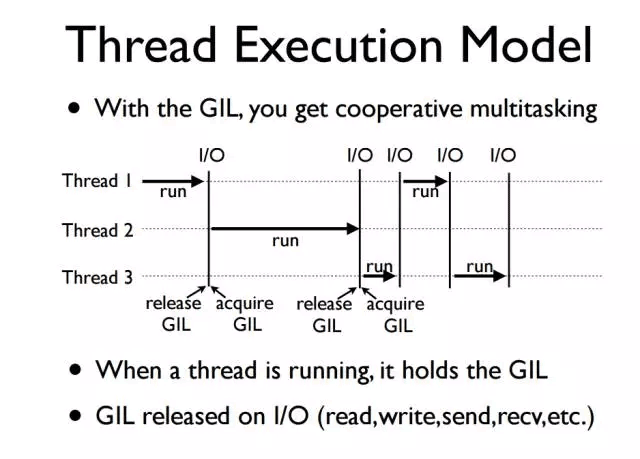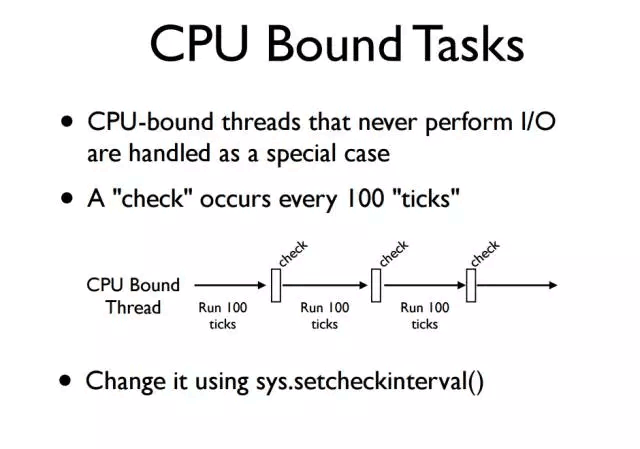- ubuntu12.04环境下使用kvm ioctl接口实现最简单的虚拟机
- Ubuntu 通过无线网络安装Ubuntu Server启动系统后连接无线网络的方法
- 在Ubuntu上搭建网桥的方法
- ubuntu 虚拟机上网方式及相关配置详解
CFSDN坚持开源创造价值,我们致力于搭建一个资源共享平台,让每一个IT人在这里找到属于你的精彩世界.
这篇CFSDN的博客文章Python多线程原理与用法实例剖析由作者收集整理,如果你对这篇文章有兴趣,记得点赞哟.
本文实例讲述了python多线程原理与用法。分享给大家供大家参考,具体如下:
先来看个栗子:
下面来看一下i/o秘籍型的线程,举个栗子——爬虫,下面是爬下来的图片用4个线程去写文件 。
|
1
2
3
4
5
6
7
8
9
10
11
12
13
14
15
16
17
18
19
20
21
22
23
24
25
26
27
28
29
30
31
32
33
34
35
36
37
38
39
40
41
42
43
44
45
46
47
48
49
50
51
52
53
54
55
56
57
|
#!/usr/bin/env python
# -*- coding:utf-8 -*-
import
re
import
urllib
import
threading
import
queue
import
timeit
def
gethtml(url):
html_page
=
urllib.urlopen(url).read()
return
html_page
# 提取网页中图片的url
def
geturl(html):
pattern
=
r
'src="(http://img.*?)"'
# 正则表达式
imgre
=
re.
compile
(pattern)
imglist
=
re.findall(imgre, html)
# re.findall(pattern,string) 在string中寻找所有匹配成功的字符串,以列表形式返回值
return
imglist
class
getimg(threading.thread):
def
__init__(
self
, queue, thread_name
=
0
):
# 线程公用一个队列
threading.thread.__init__(
self
)
self
.queue
=
queue
self
.thread_name
=
thread_name
self
.start()
# 启动线程
# 使用队列实现进程间通信
def
run(
self
):
global
count
while
(true):
imgurl
=
self
.queue.get()
# 调用队列对象的get()方法从队头删除并返回一个项目
urllib.urlretrieve(imgurl,
'e:\mnt\girls\%s.jpg'
%
count)
count
+
=
1
if
self
.queue.empty():
break
self
.queue.task_done()
# 当使用者线程调用 task_done() 以表示检索了该项目、并完成了所有的工作时,那么未完成的任务的总数就会减少。
imglist
=
[]
def
main():
global
imglist
url
=
"http://huaban.com/favorite/beauty/"
# 要爬的网页地址
html
=
gethtml(url)
imglist
=
geturl(html)
def
main_1():
global
count
threads
=
[]
count
=
0
queue
=
queue.queue()
# 将所有任务加入队列
for
img
in
imglist:
queue.put(img)
# 多线程爬去图片
for
i
in
range
(
4
):
thread
=
getimg(queue, i)
threads.append(thread)
# 阻塞线程,直到线程执行完成
for
thread
in
threads:
thread.join()
if
__name__
=
=
'__main__'
:
main()
t
=
timeit.timer(main_1)
print
t.timeit(
1
)
|
4个线程的执行耗时为:0.421320716723秒 。
修改一下main_1换成单线程的:
|
1
2
3
4
5
6
7
8
9
10
11
12
13
14
15
|
def
main_1():
global
count
threads
=
[]
count
=
0
queue
=
queue.queue()
# 将所有任务加入队列
for
img
in
imglist:
queue.put(img)
# 多线程爬去图片
for
i
in
range
(
1
):
thread
=
getimg(queue, i)
threads.append(thread)
# 阻塞线程,直到线程执行完成
for
thread
in
threads:
thread.join()
|
单线程的执行耗时为:1.35626623274秒 。

再来看一个:
|
1
2
3
4
5
6
7
8
9
10
11
12
13
14
15
16
17
18
19
20
21
22
23
24
25
|
#!/usr/bin/env python
# -*- coding:utf-8 -*-
import
threading
import
timeit
def
countdown(n):
while
n >
0
:
n
-
=
1
def
task1():
count
=
100000000
thread1
=
threading.thread(target
=
countdown, args
=
(count,))
thread1.start()
thread1.join()
def
task2():
count
=
100000000
thread1
=
threading.thread(target
=
countdown, args
=
(count
/
/
2
,))
thread2
=
threading.thread(target
=
countdown, args
=
(count
/
/
2
,))
thread1.start()
thread2.start()
thread1.join()
thread2.join()
if
__name__
=
=
'__main__'
:
t1
=
timeit.timer(task1)
print
"countdown in one thread "
, t1.timeit(
1
)
t2
=
timeit.timer(task2)
print
"countdown in two thread "
, t2.timeit(
1
)
|
task1是单线程,task2是双线程,在我的4核的机器上的执行结果:
countdown in one thread 3.59939150155 。
countdown in two thread 9.87704289712 。
天呐,双线程比单线程计算慢了2倍多,这是为什么呢,因为countdown是cpu密集型任务(计算嘛) 。

i/o密集型任务:线程做i/o处理的时候会释放gil,其他线程获得gil,当该线程再做i/o操作时,又会释放gil,如此往复; 。
cpu密集型任务:在多核多线程比单核多线程更差,原因是单核多线程,每次释放gil,唤醒的哪个线程都能获取到gil锁,所以能够无缝执行(单核多线程的本质就是顺序执行),但多核,cpu0释放gil后,其他cpu上的线程都会进行竞争,但gil可能会马上又被cpu0(cpu0上可能不止一个线程)拿到,导致其他几个cpu上被唤醒后的线程会醒着等待到切换时间后又进入待调度状态,这样会造成线程颠簸(thrashing),导致效率更低.
希望本文所述对大家python程序设计有所帮助.
原文链接:https://www.cnblogs.com/onepiece-andy/p/python-thread-analyze.html 。
最后此篇关于Python多线程原理与用法实例剖析的文章就讲到这里了,如果你想了解更多关于Python多线程原理与用法实例剖析的内容请搜索CFSDN的文章或继续浏览相关文章,希望大家以后支持我的博客! 。
我正在处理一组标记为 160 个组的 173k 点。我想通过合并最接近的(到 9 或 10 个组)来减少组/集群的数量。我搜索过 sklearn 或类似的库,但没有成功。 我猜它只是通过 knn 聚类
我有一个扁平数字列表,这些数字逻辑上以 3 为一组,其中每个三元组是 (number, __ignored, flag[0 or 1]),例如: [7,56,1, 8,0,0, 2,0,0, 6,1,
我正在使用 pipenv 来管理我的包。我想编写一个 python 脚本来调用另一个使用不同虚拟环境(VE)的 python 脚本。 如何运行使用 VE1 的 python 脚本 1 并调用另一个 p
假设我有一个文件 script.py 位于 path = "foo/bar/script.py"。我正在寻找一种在 Python 中通过函数 execute_script() 从我的主要 Python
这听起来像是谜语或笑话,但实际上我还没有找到这个问题的答案。 问题到底是什么? 我想运行 2 个脚本。在第一个脚本中,我调用另一个脚本,但我希望它们继续并行,而不是在两个单独的线程中。主要是我不希望第
我有一个带有 python 2.5.5 的软件。我想发送一个命令,该命令将在 python 2.7.5 中启动一个脚本,然后继续执行该脚本。 我试过用 #!python2.7.5 和http://re
我在 python 命令行(使用 python 2.7)中,并尝试运行 Python 脚本。我的操作系统是 Windows 7。我已将我的目录设置为包含我所有脚本的文件夹,使用: os.chdir("
剧透:部分解决(见最后)。 以下是使用 Python 嵌入的代码示例: #include int main(int argc, char** argv) { Py_SetPythonHome
假设我有以下列表,对应于及时的股票价格: prices = [1, 3, 7, 10, 9, 8, 5, 3, 6, 8, 12, 9, 6, 10, 13, 8, 4, 11] 我想确定以下总体上最
所以我试图在选择某个单选按钮时更改此框架的背景。 我的框架位于一个类中,并且单选按钮的功能位于该类之外。 (这样我就可以在所有其他框架上调用它们。) 问题是每当我选择单选按钮时都会出现以下错误: co
我正在尝试将字符串与 python 中的正则表达式进行比较,如下所示, #!/usr/bin/env python3 import re str1 = "Expecting property name
考虑以下原型(prototype) Boost.Python 模块,该模块从单独的 C++ 头文件中引入类“D”。 /* file: a/b.cpp */ BOOST_PYTHON_MODULE(c)
如何编写一个程序来“识别函数调用的行号?” python 检查模块提供了定位行号的选项,但是, def di(): return inspect.currentframe().f_back.f_l
我已经使用 macports 安装了 Python 2.7,并且由于我的 $PATH 变量,这就是我输入 $ python 时得到的变量。然而,virtualenv 默认使用 Python 2.6,除
我只想问如何加快 python 上的 re.search 速度。 我有一个很长的字符串行,长度为 176861(即带有一些符号的字母数字字符),我使用此函数测试了该行以进行研究: def getExe
list1= [u'%app%%General%%Council%', u'%people%', u'%people%%Regional%%Council%%Mandate%', u'%ppp%%Ge
这个问题在这里已经有了答案: Is it Pythonic to use list comprehensions for just side effects? (7 个答案) 关闭 4 个月前。 告
我想用 Python 将两个列表组合成一个列表,方法如下: a = [1,1,1,2,2,2,3,3,3,3] b= ["Sun", "is", "bright", "June","and" ,"Ju
我正在运行带有最新 Boost 发行版 (1.55.0) 的 Mac OS X 10.8.4 (Darwin 12.4.0)。我正在按照说明 here构建包含在我的发行版中的教程 Boost-Pyth
学习 Python,我正在尝试制作一个没有任何第 3 方库的网络抓取工具,这样过程对我来说并没有简化,而且我知道我在做什么。我浏览了一些在线资源,但所有这些都让我对某些事情感到困惑。 html 看起来

我是一名优秀的程序员,十分优秀!